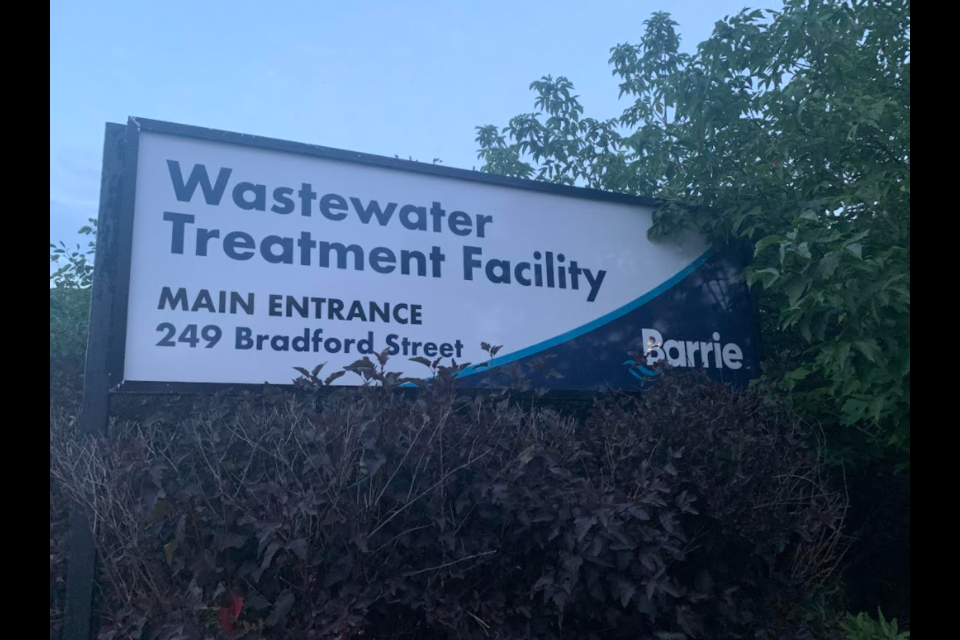BURSZTYN: Creating power from organic waste can be a lot to digest

The City of Barrie’s wastewater treatment facility on Bradford Street. | Raymond Bowe/BarrieToday
From BarrieToday, January 16, 2022
By Peter Bursztyn
Organic waste is everything which started out as either plant or animal matter. It includes wilted cabbage, banana peel, corn stubble, excess fat skimmed from homemade stew and, of course, the stuff we all flush down the toilet.
Few Barrie residents know that our municipal sewage treatment plant has been converting the organic waste it receives into methane gas for three decades. Our sewage plant uses this gas to power generators producing much of the electricity and warmth it needs to operate.
The process by which organic matter becomes methane gas (the natural gas we use to warm our houses) is called anaerobic digestion and done by microbes. It is anaerobic because it happens in the absence of oxygen.
This methane is burned to power generators. Barrie’s sewage plant uses “reciprocating engines” – large versions of the motors powering our cars. Gas turbines are used in larger installations.
Not all of the heat of combustion can be made to turn the wheels of our car. Waste heat remains and must be lost to the environment. Cars circulate coolant through a radiator to do this; 70 per cent of the fuel’s energy is lost this way. Heavy highway trucks are more efficient, wasting just 55 per cent of their fuel’s energy.
Our sewage plant’s efficiency is even higher, transforming over 50 per cent of the fuel’s energy into electricity. But the heat produced is not wasted; it is used to warm the incoming sewage.
The incoming sewage is warmed to make digestion proceed faster. This means treatment can occur within a much smaller footprint. I am sure we are glad our sewage plant occupies as little as possible of our precious waterfront. Knowing it is largely powered by material in sanitary sewers should make us even happier.
We casually discard far more organic material than we use. Before COVID chased me (and other volunteers) out of our Royal Victoria Regional Health Centre (RVH), I was thinking about hospital food waste. As a volunteer porter, I often passed the RVH kitchens to see trays returning from the wards with uneaten food – unsurprising since many ill patients have little appetite.
A half ham sandwich or partly eaten salad are potentially contaminated and must be discarded. Long ago, such food waste would have been fed to farm pigs. However, bio-security regulations make this impossible at a modern hog farm today. Instead, the (taxpayer-funded) hospital pays a contractor to haul it to a purpose-built facility paid to accept it. In our area, that facility is All Treat Farms in Arthur, Ont.
They take solid organic waste from many municipalities, including Barrie, 110 kilometres away. RVH may use the same facility.
RVH is embarking on a major expansion. This creates an opportunity to integrate anaerobic digestion and power generation into the new construction. Designing something into the initial plan is easier and cheaper than retrofitting it to an existing structure.
What am I proposing?
I would like to see RVH integrate a compact, high temperature anaerobic organics digester into the hospital’s new construction. This would collect food waste from the hospital and its cafeterias. It would also intercept the hospital’s sanitary sewer for more organics.
Nearby Georgian College should be eager to add their food waste to this. After all, they now pay to have it hauled far away.
It is worth mentioning that anaerobically digested food waste, yields five times more methane than the same material would after transiting a human digestive system. Why should the hospital produce methane?
All hospitals are required to maintain electricity generation equipment as a back-up in case the grid fails.
However, these are generators run only to ensure they remain operational! It makes sense to use this expensive equipment to get value from the substantial investment. A hospital always needs hot water for laundry, kitchens, sterilizers, etc., needs normally covered by burning gas or using electricity. But they could use waste heat from their own generating equipment.
Of course, electricity from a small-scale generator is more expensive than it would cost from a large central facility. However, locally generated electricity would not pay grid transmission and local distribution charges. Also, the ability of a “cogeneration unit” to use waste heat (roughly half the energy in the fuel) should make such an installation economically attractive since the methane fuel is cost free, as is the waste heat.
The potential to collect carbon credits in future (by avoiding the methane emissions from normal composting) could be an added bonus. How would this work?
Organic material to feed the digester would be pumped from within the hospital and also from Georgian College, half-kilometre away. Additional organic waste could come from local condo towers, restaurants, grocery stores, restaurants, etc.
But wouldn’t that create odour?
Yes, it would, but the engines generating the power would have their intake within the facility creating a negative pressure. Any odours would be aspirated into the engine and burnt to create an odourless exhaust.
Organic waste is a potential biohazard harbouring many microbes, some of which could be pathogens with the potential to cause disease.
The City of Barrie’s sewage plant is “mesophyllic”, operating at 35 to 40 Celsius. It is possible to operate a “thermophyllic” anaerobic digester running at 50 to 60 C.
That temperature kills all pathogens, rendering the output harmless. Thermophylic systems are much faster but also fussier than mesophylic with respect to pH, temperature and feedstock. However, a professionally operated facility should easily manage these parameters. Rapid digestion equates to a smaller “footprint” – valuable in an urban unit.
Finally, thermophyllic systems produce more, higher quality methane gas.
I have discussed this with RVH’s supervisor of facilities. He had already considered co-generation for RVH’s new back-up power. The potential to create their own fuel from organic waste definitely interested him.
I hope he finds progressive, imaginative engineers to help bring such a system to our hospital. As a society, we need to stop treating our organic waste as garbage – it’s a resource and should use it.









Leave a Reply